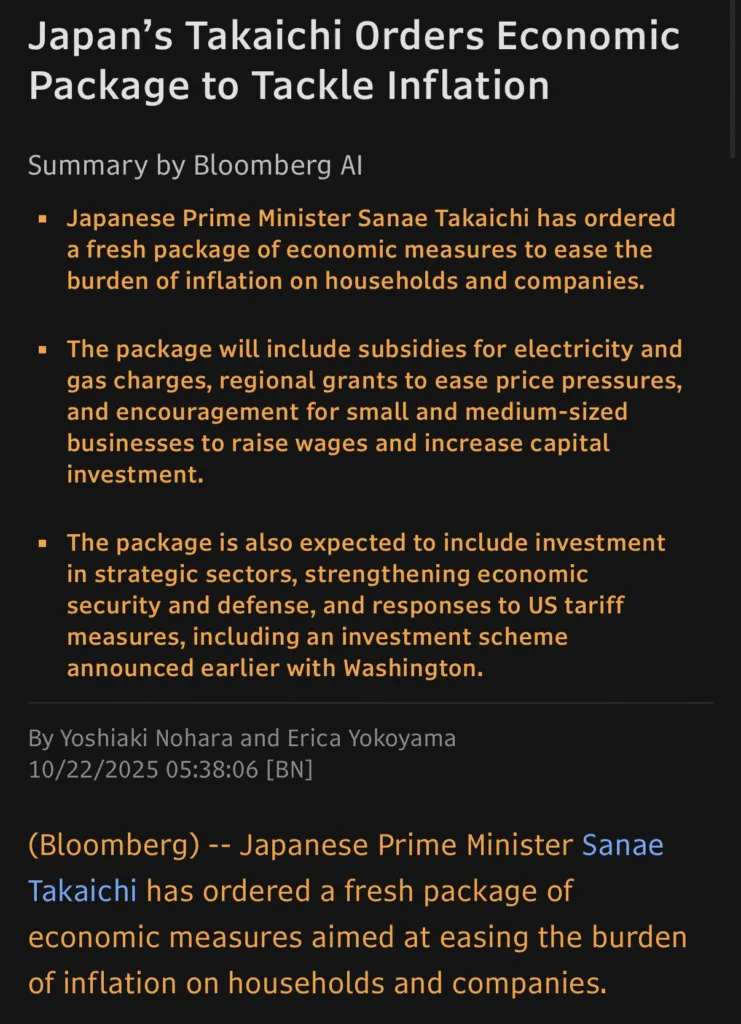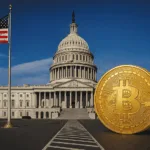- Japan’s new Prime Minister, Sanae Takaichi, unveiled a major economic stimulus package to ease inflation pressure on households.
- Arthur Hayes, BitMEX co-founder, predicts Japan’s return to quantitative easing (QE) could propel Bitcoin to $1 million.
- Bitcoin whales reentered the market, opening large leveraged positions following a brief price dip to $104,000.
Japan’s newly elected Prime Minister Sanae Takaichi announced a sweeping package of economic stimulus measures on Tuesday aimed at mitigating the impact of inflation on households and small businesses.
The initiative includes subsidies for electricity and gas bills, along with regional grants designed to help small and medium-sized enterprises raise wages and sustain operations. The plan, according to analysts, reflects a renewed willingness by Japan’s government to deploy fiscal expansion in support of domestic demand.
Crypto investors are now eyeing potential spillover effects for Bitcoin (BTC). Arthur Hayes, co-founder of BitMEX, suggested that the policy direction could mark the beginning of another fiat liquidity wave that drives capital into crypto markets.
Newsletter
Get weekly updates on the newest crypto stories, case studies and tips right in your mailbox.
“Translation: let’s print money to hand out to folks to help with food and energy costs,” Hayes wrote on X (formerly Twitter). He argued that such monetary stimulus could set Bitcoin on a path to $1 million, while simultaneously pushing the Japanese yen higher in the short term.
Following Takaichi’s announcement, the yen slipped to a one-week low, according to Reuters, reflecting mixed investor sentiment about Japan’s upcoming monetary policy stance.

Source: Arthur Hayes
QE pivot may be next big Bitcoin catalyst
Hayes has long maintained that a Bank of Japan (BOJ) shift toward quantitative easing (QE) could serve as a major catalyst for Bitcoin and other risk assets. QE which involves central banks purchasing government bonds to inject liquidity into the economy — typically reduces interest rates and encourages investment in alternative assets.
The BOJ is currently engaged in quantitative tightening (QT), aiming to cool inflation and stabilize bond yields. However, analysts suggest that Takaichi’s pro-stimulus policies may pressure the central bank to pivot back toward easing in 2025.
The BOJ’s next policy meeting is scheduled for October 29, with most economists expecting a 0.75% rate hike by early 2026, though opinions differ on timing.
According to macro research outlet Milk Road Macro, Japan could soon join the 80% of global central banks already running QE programs, potentially fueling the next liquidity-driven Bitcoin rally.
Bitcoin whales renew bullish bets
Meanwhile, large Bitcoin investors often referred to as whales are showing renewed confidence in the market after Bitcoin briefly dropped to $104,000 last Friday, its lowest level in four months.
Data from blockchain analytics platform Lookonchain revealed that three major whale wallets deposited tens of millions of dollars onto decentralized exchange Hyperliquid this week to open leveraged long positions.
One address, “0x3fce,” reportedly increased its Bitcoin long to $49.7 million, while another wallet, “0x89AB,” opened a 6x leveraged position worth $14 million. These moves signal growing conviction among large traders that Bitcoin’s correction is temporary and that macro conditions, particularly in Japan, could soon ignite the next leg of the bull market.













